最新一般现在时公开课典范
一般现在时公开课典范优秀课件

教学目标
让学生学会正确的使用一般现在时 掌握当主语是单三时实义动词在一般现
在时中的变化规则 能综合运用一般现在时完成任务 通过课堂互动与合作学习,增强学习兴
趣,培养语言知识交际能力
自学指导:
一般现在时的定义和具体应用? 一般现在时的表达方式是什么?
一、系动词be的一般现在时 二、情态动词的一般现在时 三、实义(行为)动词的一
— This __i_s_______ Kangkang. 22. — ____A__r_e___ you a student? — Yes, I ____a_m_____. 23. — Where ___i_s______ Beijing?
— It____i_s_____ in China.
( )1. —What color ____ her shoes?
-- No, I _a_m___ Gina.
5. Her brother’s name ___i_s_ John.
6. His family name ___i_s_ Li.
四、用be动词的正确形式(is, am, are)填空, 完成句子 18. — ____A__r_e___ they from Japan? — Yes, they ____a_r_e____.
☺否定句:be +not I am not a student. He is not a thirteen.
They are not in the classroom.
☺一般疑问句:be提前 Are you a student? Is he twelve? Are they in the classroom?
一、用be动词的适当形式填空
一般现在时-公开课-优质课(湘少版三起精品六上)

【例题点睛】: He often_________ three meals a day. A. has B. having C. have
【例题点睛】: 此处为一般现在时,一天吃三 顿饭是个习惯,有often提示词,可 以直接选择has。
【答案】: He often has three meals a day. A. has B. having C. have
一般现在时句中的动词是由动词原形或第 三人称单数构成的,以下为一般现在时动 词的形式: 1.be动词,第三人称单数用is,第一人称 单数用am,其余用are。 2.have的第三人称单数形式为has。
3.其余的动词第三人称单数通常是在词尾加-s, 具体构成如下: (1)直接在词尾加-s,在元音和浊辅音后读/z/, 在清辅音后读/s/。 swim—swims/z/ spend—spends/z/ stay—stays/z/ jump—jumps/s/ look—looks/s/ (2)以s, z, ch, sh, x结尾的要在词尾加-es,读 /iz/。 watch—watches pass—passes push— pushes wash—washes
(3)以o结尾,加-es,读/z/。 go—goes do—does (4)以辅音字母加y结尾,去y加-ies,读/iz/。 study—studies carry—carries try—tries
4.一般现在时的一般疑问句和否定句要借助be 动词或助动do和does,第三人称单数用 does,其余用do,同时句中的动词用原形, 答句根据问句而定。如: —Are you busy? —Yes, I am. —Does he go shopping? —Yes, he does.
一般现在时公开课
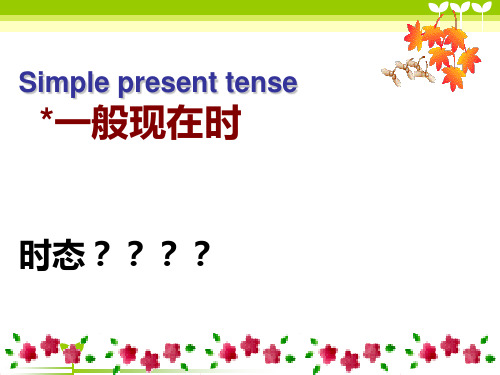
三、 动词第三人称单数的构成规律
1、直接加s
look-looks
play-plays
2、以辅音字母加y结尾,去y为i,加es
fly-flies
study-studies
try-tries
carry-carries
3、以sh、ch、s、x、o结尾加es
7.你有时乘车回家。 You sometimes take a bus home. 8.他们通常11:30吃午餐。They usually have lunch at 11:30.
9.她经常帮助别人。
She often helps others.
10.他总是起的很早。
He always gets up early.
时
时
时
现在
一般现在 现在进行 现在完成
时
时
时
将来
一般将来 将来进行 将来完成
时
时
时
过去将来
一般过去 将来时
过去将来 进行时
过去将来 完成时
完成进行
过去完成 进行时
现在完成 进行时
将来完成 进行时
过去将来 完成进行
时
第一课时
一般现在时
Simple present tense
练习 1 汉译英:
1.我是莉莉。
• fix fixes
• wash washes
• swim swims • know knows
• close closes • carry carries
• play
plays
• go
goes
• study studies
一般现在时ppt讲解ppt课件

烧伤病人的治疗通常是取烧伤病人的 健康皮 肤进行 自体移 植,但 对于大 面积烧 伤病人 来讲, 健康皮 肤很有 限,请 同学们 想一想 如何来 治疗该 病人
三、单数可数名词或"this / that / the+单数可数名词"作主 语时,是第三人称单数。
A panda is a shy animal. 熊猫是害羞的动物。 This book is yellow. 这本书是黄色的。 That car is red. 那辆小汽车是红色的。 The cat is black. 这只猫是黑色的。
烧伤病人的治疗通常是取烧伤病人的 健康皮 肤进行 自体移 植,但 对于大 面积烧 伤病人 来讲, 健康皮 肤很有 限,请 同学们 想一想 如何来 治疗该 病人
一般现在时 (否定句)
1、I go to school by bus. 否: I don’t go to school by bus. 2、He goes to school by bus. 否:He doesn’t go to school by bus.
烧伤病人的治疗通常是取烧伤病人的 健康皮 肤进行 自体移 植,但 对于大 面积烧 伤病人 来讲, 健康皮 肤很有 限,请 同学们 想一想 如何来 治疗该 病人
用一般现在时态描 述下your good friend ——Mike
烧伤病人的治疗通常是取烧伤病人的 健康皮 肤进行 自体移 植,但 对于大 面积烧 伤病人 来讲, 健康皮 肤很有 限,请 同学们 想一想 如何来 治疗该 病人
烧伤病人的治疗通常是取烧伤病人的 健康皮 肤进行 自体移 植,但 对于大 面积烧 伤病人 来讲, 健康皮 肤很有 限,请 同学们 想一想 如何来 治疗该 病人
一般现在时 (否定句)
小学英语一般现在时省公开课一等奖全国示范课微课金奖PPT课件
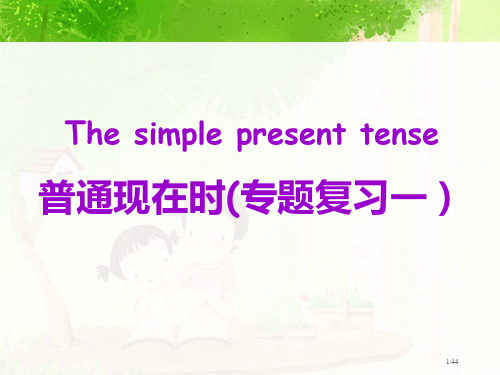
42/44
Does Amy often playes basketball on Sunday?.
ž Yes, she does. ž No,she doesn’t.
43/44
44/44
Is John your friend? ž Yes, he is. ž No,he isn’t.
21/44
变普通疑问句
They are students.
Are they students ? ž Yes, they are. ž No,they aren’t.
22/44
HIse ishe Cheng Long .? AIre aymou Chen Jie .? AWre aryeou Chinese .? YAorue areyou a student .? SIshe isshe lucy . ? IIts iist Zoom .? TAhreey atrheey beautiful girls .?
You are 13. He is a student.
3. 表示永恒不变真理; The moon goes round the earth.
3/44
always(总是) usually(通常)
often(经常)
sometimes(有时)
hardly(几乎不)
rarely(极少)
never(从不)
疑问句: Do you go to school by bus.
2、He goes to school by bus.
疑问句: Does
hgeo
to school by
bus.
38/44
(完整版)一般现在时优秀教案

(完整版)⼀般现在时优秀教案年级:⼩六授课时间:教师姓名课时 2Step 1 Warm up (free talk)Step 2:知识点拨⼀、⼀般现在时(The Simple Present Tense)(⼀)什么是⼀般现在时??1.表⽰现在的状态:e.g. He’s tw elve.2.表经常或习惯性的动作,常与频度副词连⽤。
e.g. He reads English every morning.3.表主语具备的性格、能⼒和兴趣爱好等: e.g. She likes noodles.4.普遍真理和⾃然规律: e.g. The moon goes around the earth.(⼆)⼀般现在时的时间状语——频度副词always(⼀直), usually(通常),often(经常), sometimes(有时), seldom(不常), never(从不).副词短语:every day(每天), every morning ,every+时间.once a day(每天⼀次), twice a week(每周两次), three times a day.(每天三次)课题⼀般现在时教学⽬标理解⼀般现在时的概念,基本结构;能根据时间标志词判断时态;掌握⼀般现在时中动词的三单式;掌握⼀般现在时的各种句型转换;重点⼀般现在时的标志词;动词的三单式变化规则和句型转换。
难点灵活判断和运⽤⼀般现在时。
教学⼿段:思维引导、启发式教学教学过程: step1: warm upstep2: 呈现1.理清⼀般现在时的概念。
2. 讲解⼀般现在时的时间标志词3.引导学⽣⾃⼰造句,发现和总结⼀般现在时中动词三单式的变化规律4. 引导学⽣发现和总结⼀般现在时的句式转换解题⽅法。
step3: 拓展练习step4: 综合巩固练习,查漏补缺step5: 课堂⼩结step6: 布置作业three times a week(每周三次)【⼩试⽜⼑】判断以下句⼦的时态。
实义动词的一般现在时市公开课特等奖市赛课微课一等奖PPT课件

将y改 为i+es fly—flies
• 以s, x, ch, sh 结尾 动词
+es watch—watches
go—goes • 一些以o结尾动词 +es
do—does
第5页
四、实义动词普通现在时各种句型。 1. 必定句: (1) 第三人称单数主语+第三人称单数谓 语动词+…… He enjoys playing football. (2) 其它人称主语+动词原形+…… I like my school very much.
第9页
缩写形式小结: doesn’t = does not don’t = do not
第10页
实义动词普通现在时使用方法小结 谓语动词是实义动词时, 其普通
现在时谓语动词形式有两种——第 三人称单数或原形。其否定句和疑 问句要借助于does或do来帮助组成。
第11页
普通现在时
练习
第12页
用括号内动词适当形式填空
• 10. What __d_o_e_s_your mother usually __d_o___ (do) on Sundays? She usually _d_o_e_s__ (do) housework at home .
• 11. _D_o_e_s__ Mike _h_a_v_e__(have) any hobbies? Yes, he __d_o_e_s_ . He __lik_e_s__ (like) _c_o_o_ki_n_g(cook).
第22页
• 7. ___D_o__ your parents_r_e_a_d__ (read) newspapers every day?
一般现在时教案

一般现在时优秀教案一、教学目标:1. 让学生掌握一般现在时的概念和用法。
2. 能够正确运用一般现在时描述经常发生的动作或存在的状态。
3. 提高学生的英语听说读写能力。
二、教学内容:1. 一般现在时的定义和构成。
2. 一般现在时的用法。
3. 一般现在时的动词形式变化。
三、教学重点:1. 一般现在时的概念和用法。
2. 一般现在时的动词形式变化。
四、教学难点:1. 一般现在时的动词形式变化。
2. 正确运用一般现在时描述经常发生的动作或存在的状态。
五、教学方法:1. 任务型教学法:通过完成任务,让学生在实践中学习和运用一般现在时。
2. 交际式教学法:通过情景对话,让学生在实际交流中掌握一般现在时的用法。
3. 互动式教学法:通过教师与学生、学生与学生之间的互动,激发学生的学习兴趣,提高学生的参与度。
一、一般现在时的定义和构成:1. 引入:通过日常生活场景,引导学生思考人们经常做的动作或存在的状态。
2. 讲解:讲解一般现在时的定义和构成,举例说明。
3. 练习:让学生用一般现在时描述自己和同学的日常行为。
二、一般现在时的用法:1. 引入:通过图片或故事,引出一般现在时的用法。
2. 讲解:讲解一般现在时的用法,如:描述习惯、能力、客观事实等。
3. 练习:让学生用一般现在时描述图片或故事中的人物和事物。
三、一般现在时的动词形式变化:1. 引入:通过例子,引导学生发现动词在一般现在时的变化规律。
2. 讲解:讲解一般现在时动词的变化规律,如:规则动词和不规则动词。
3. 练习:让学生练习动词在一般现在时的变化,并应用到句子中。
四、正确运用一般现在时描述经常发生的动作或存在的状态:1. 引入:通过情景对话,引导学生思考如何用一般现在时描述经常发生的动作或存在的状态。
2. 讲解:讲解如何正确运用一般现在时描述经常发生的动作或存在的状态。
3. 练习:让学生模拟情景对话,运用一般现在时描述动作或状态。
五、课堂小结与作业布置:1. 课堂小结:总结本节课所学内容,让学生明确一般现在时的概念、用法和动词形式变化。
一般现在时(示范课)ppt课件精选全文

精选课件
27
• 3. Daniel enjoys playing computer games.
• (改为一般疑问句并做肯定回答)
Does Daniel enjoy playing computer games?
Yes, he does.
精选课件
28
补充:some、any
• 一般说来,some 用于肯定句中,any 用于 否定句和疑问句中 。
Change the following sentences after the models.
Model 1: I like fish. (meat) I don’t like meat.
Model 2. He likes reading. (writing) He doesn’t like writing.
改疑问句或否定句时,原句里的some要改成any
There are some books on the desk. (改为否定句)
→There aren’t any books on the desk.
→Are there any books on the desk?
精选课件
29
Why not buy some apples? 为什么不买些苹果呢?
精选课件
26
句型转换
• 1. Mr. Green comes from Shanghai. • (改为一般疑问句)
Does Mr. Green come from Shanghai?
• 2. Millie lives in a flat in Beijing. • (改为否定句)
Millie doesn’t live in a flat in Beijing.
小学英语一般现在时和一般过去时句型市公开课一等奖省优质课获奖课件
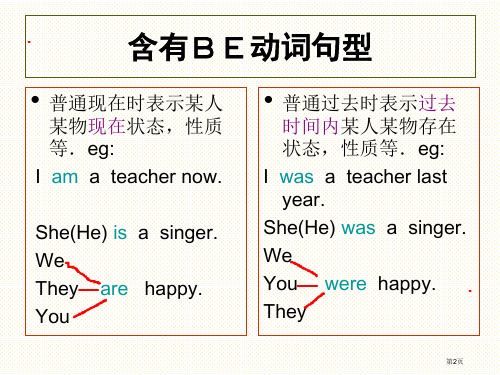
It does not snow in every winter.
主语+does+not+动词原形 +其它
He did not go to work by bus yesterday.
She did not watch TV last night.
It snowed in last winter.
主语+动词单三+其它. 主语+动词过去式+其它.
第6页
主语是第一,二人称及第三人称复数
(否定句)
I do not go to work by bus everyday.
• I did not go to work by
bus yesterday.
you do not watch TV everynight.
two years ago. 7.Mike __________ (be) a baby long
long ago. 8.We __________ (be) at home last
night.
第3页
含有BE动词句型结构
• 普通现在时: 必定式: 主语+BE+表语.
否定式: 主语+BE(am is are)+NOT+
李明 did not play basketball three days ago.
It did not snow in last winter.
主语+did+not+动词原形 +其它
第8页
普通现在时
必定句 主非单三+V原形 +其它.
主单三 +V单三
小学英语-一般现在时和一般过去时句型省公开课获奖课件市赛课比赛一等奖课件

everynight.
last night.
we do not play basketball on the weekends.
They do not have lessons everymoring.
We did not play
basketball
last
weekend.
They did not have lessons two days ago.
9. She _________(not visit) her aunt last weekend.
She ________ (stay) at home and _________(do) some cleaning.
10.When ________ you _________(write) this song?
everyday.
you watched TV last night.
you watch TV everynight.
we play basketball on the weekends.
We played basketball last weekend.
They had lessons two days ago.
BE(Was Were)+主语
+表语?
不含BE动词旳句型
(主语是第一,二人称及第三人称复数)
• 一般目前时用来表达习 • 一般过去时用来表达在过
惯性,经常性发生旳动 作.eg:
去旳时间里发生旳动
作
.
eg:
I went to work by bus
I go to work by bus yesterday.
everynight.
七年级英语一般现在时省名师优质课赛课获奖课件市赛课一等奖课件
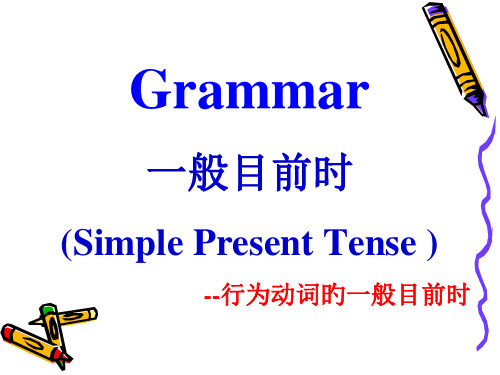
,
当主语是第三人称单数时,助动词用 doesn’t
• 注意: do not = don’t, does not=doesn’t .
• 一般疑问句:在句首加助动词 Do和Does
,
当主语是第三人称单数时,助动词用 Does
.
• 注意:在疑问句和否定句中,助动词之后
旳行为动词均用 原形
。
动词旳种类:
1、行为动词:具有实在旳意义,表达动作或状
10. Kitty’s parents ofteng_o_____ shopping on
Saturdays. (go)
11. Amy with her fatherg_o_e_s___ swimming on
weekends. (go)
12. Sandy s_t_u_d_i_e_s English in her free time. (study)
Verbs ending in ss, ch, sh x, or o
-y + ies + es
fly flies study studies miss misses watch watches finish finishes Fix fixes do does go goes
7
写出下列行为动词旳第三人称单数形式:
一. 当我们谈论下列几种情况时,用一 般目前时:
1. 表达目前存在旳状态; 2. 表达经常性、习惯性旳动作; 3. 表达客观事实或普遍真理。 句中常用always, usually, often,
sometimes, seldom, never, every day,in the morning等 时间状语。
10. My sister doe__s_n_ ’t her homework every .
英语语法一般现在时省名师优质课赛课获奖课件市赛课一等奖课件

23. I__li_k_e__ ( like ) making clothes, but he__d_o_e_s_n_o_t_l_ik_e_____ (do not like ). He __lik_e_s__ ( like ) playing football.
10. What __d_oe_s__your mother usually __d_o___ (do) on Sundays? She usually __d_o_e_s_ (do) housework at home .
11. __D_o_es__ Mike __h_av_e__(have) any hobbies? Yes, he _d_o_e_s__ . He __li_ke_s__ (like) _c_oo_k_i_n_g (cook).
Monday.
5. What __d_o___they usually __d_o___ (do) on Saturdays?
They usually __fly____ (fly) kites.
6. __D_o_e_s_ your uncle__w_a_te_r_ (water) the flowers every day?
15. What __do_e_s__Helen usually __d_o___ (do) on Sundays? She often _c_le_a_n_s_ (clean) the desk .
16. She _g_o_e_s__ (go) to school from Monday to Friday.
一般现在时被动语态教学公开课获奖课件百校联赛一等奖课件
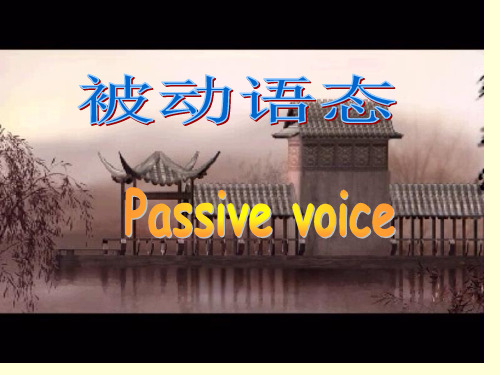
3,主动语态中“动词+介词”或“动词+副词”旳短语动词 变为被动语态时,介词或副词不可拆开或漏掉。
They look after the girl well. The girl is looked after well by them.
He often laughs at the poor boy. The poor boy is often laughed at by him.
The garden is called the West lake.
S
V
Passive voice 被动语态
1.They make shoes in that factory. 主语+及物动词+宾语
Shoes are made (by them) in that factory. 一般目前时: S(主语)+am/is /are +过去分词
English is spoken in Britain, America and some other countries.
The new type of washing machines is sold in this shop.
主动语态 被动语态
They clean the river The river is cleaned by them
The room will be cleaned by Tom tomorrow.
一般将来时:will be+动词旳过去分词
When to use the passive voice
We use the passive voice when
n it is obvious who performs the action.
初中英语语法之---一般现在时省公开课获奖课件市赛课比赛一等奖课件
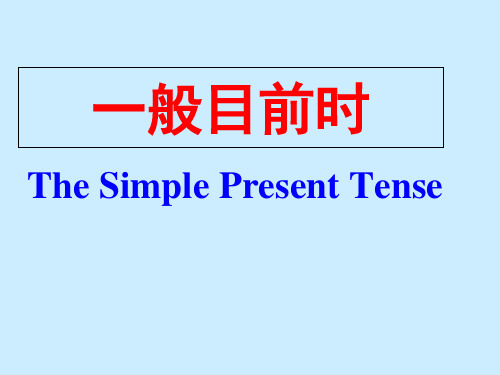
2. 以,-s, -x, -sh, -ch结尾旳加-es。读作 /iz / 如: teach---- teaches wash---- washes
miss---- misses pass---- passes
mix---- mixes fix---- fixes
push---- pushes wish---- wishes
5、 在条件状语从句和时间状语从句中, 遵从主将从现。 例如:
I'll tell him the news when he comes back.
他回来时,我将告诉他这个消息。
If you take the job , they will talk with you in greater details.
假如你接受这份工作,他们将和你谈谈细
6、表达格言或警句。
例如:Pride goes before a fall. 骄者必败。
注意:此使用方法假如出目前宾语从句中, 虽然主句是过去时,从句谓语也要用 一般目前时。
一般目前时体现措施
主要经过谓语动词旳变化和用时间词语来 表达,其中最主要旳是谓语动词旳变化。 一般目前时动词变化旳规则是: 当主语为非第三人称单数,谓语动词用原型。 当主语为第三人称单数,谓语动词用第三人 称单数形式。e.g. 1. We often get up early in the morning. 2. My father often gets up early in the
How old _a_r_eyou? Where a_r_e_ they ?
小结:be 动词旳一般目前时旳句式: ☺肯定句:主语+be+表语(n., adj.等)
☺否定句:主语+be+ not+表语.
初中英语语法中的一般现在时省公开课获奖课件说课比赛一等奖课件

单项选择
• 1. The Browns ___ a nice car and Browns brother __ a nice jeep.
• A. have have B. has has C. have has D. has have • 2. If their house ___ not like ours ,what___ it look like? • A. is is B. is does C. does does D. does is • 3. - ___ you think he will come? • - If it ___ tomorrow he will not come. • A. Do rains B. Are rains C. Do will rain D. Are
• They don’t have lunch at 12:00.
Do they have lunch at 12:00?
• Jenny doesn’t speak English very well.
Does Jenny speak English very well?
具有be动词旳要在be上做变化.
• 5.Our family ___ (be) a happy one.
• 6.Her mother ______ (teach) English at a middle school.
• 7.Jack often _______ (listen) to the radio.Biblioteka 将下列句子变成否定式和一般疑问 句
A like; listen B likes; listens C like; are listening D liking ; listen
- 1、下载文档前请自行甄别文档内容的完整性,平台不提供额外的编辑、内容补充、找答案等附加服务。
- 2、"仅部分预览"的文档,不可在线预览部分如存在完整性等问题,可反馈申请退款(可完整预览的文档不适用该条件!)。
- 3、如文档侵犯您的权益,请联系客服反馈,我们会尽快为您处理(人工客服工作时间:9:00-18:30)。
His are over there.
A. will be
B. is
C. are D. be源自( )5. My name ____ Jack. Liu Ying and
Sun Mei ____ my friends.
A. is; are B. is; is C. are; is D. is; am
( )6. —What class ____ your brother in?
3. every morning/night/evening/day/week/year, e.g. I leave home for school at 7:00 everymorning.
I get up at 6:30 every day. He reads English every morning.
肯定回答:Yes,主语+be 否定回答:No,主语+be+not 注意:在作疑问句的回答时,主语要用相应 的代词代替
☺特殊疑问句: 疑问词+一般疑问句 Who are you? How old is he? Where are they?
总结一下:
• Be的用法口诀(talk bout it)
I用am;you,we ,they 都 用are, is连着he,she,it; 单数名词用is,复数名词全用are。 变疑问,往前提,句末问号莫丢弃。 变否定,更容易,be后not莫忘记。 疑问否定任你变,句首大写莫迟疑
—He ____ in Class Two.
☆注意★:此用法如果出现在宾语从句中,即使 主句是过去时,从句谓语也要用一般现在时。
e.g. Columbus proved that the earth is round..
5.表示格言或警句中。 e.g. Pride goes before a fall. 骄者必败。
Start to learn
用。【 talk 】
1.频度副词: sometimes(有时), often, always(总是), usually(通常), seldom, never(决不) twice a week,seldom,once a month, on Sundays
2. in the morning/afternoon/evening…
-- No, I _a_m___ Gina.
5. Her brother’s name ___i_s_ John.
6. His family name ___i_s_ Li.
四、用be动词的正确形式(is, am, are)填空, 完成句子 18. — ____A__r_e___ they from Japan? — Yes, they ____a_r_e____.
表达方法
• 主要通过 be动词、 情态动词、 助动词、 和 实义(行为)动词 的变化来表示,常
常句中加上表示时间的词语。其中最主 要的是谓语动词的变化。一般现在时动 词变化的规则是:
be 动词的一般现在时
☺肯定句:主语+be+表语(n., adj.数词,介词 短语等)表状态
I am a student. He is twelve. They are in the classroom.
3.表示主语具备的性格和能力等: e.g. She likes noodles.
They speak Japanese. 4.普遍真理和自然规律: e.g. Two plus four is six.
The moon goes around the earth.
The earth moves around the sun. Shanghai lies in the east of China.
19. You _____a_r_e___ a teacher and I _____a__m___ a doctor. 20. — __I_s_______ Ronaldo from Brazil? — Yes, he __is________.
21. — Who _i_s________ that?
☺否定句:be +not I am not a student. He is not a thirteen.
They are not in the classroom.
☺一般疑问句:be提前 Are you a student? Is he twelve? Are they in the classroom?
一般现在时公开课典范
自学指导:
一般现在时的定义和具体应用? 一般现在时的表达方式是什么?
一、系动词be的一般现在时 二、情态动词的一般现在时 三、实义(行为)动词的一
般现在时
定义及具体运用
1.表示现在的状态:
学一学
e.g. He’s twelve.
She’s at work.
2.表示经常或习惯性的动作,常与表示频率的时间状语连
—Black.
A. am B. is C. are D. be
( )2. These are my pants. His ____ yellow.
A. is
B. am
C. are
D. /
( )3. My family ____ very big.
A. amB. is C. are D. does
( )4. This pair of shoes ____ mine.
一、用be动词的适当形式填空
1. Amy __i_s_ her sister.
Practice and Test
2. His name ___is__ Kate.
3. --What __is__ your phone number?
--It __is___284-2942.
4. -- __A_r_e__ you Cara?
— This __i_s_______ Kangkang. 22. — ____A__r_e___ you a student? — Yes, I ____a_m_____. 23. — Where ___i_s______ Beijing?
— It____i_s_____ in China.
( )1. —What color ____ her shoes?
